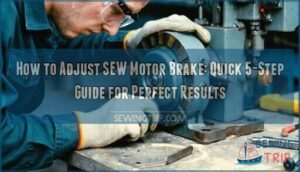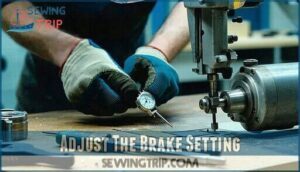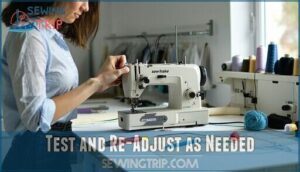This site is supported by our readers. We may earn a commission, at no cost to you, if you purchase through links.
 Adjusting your SEW motor brake isn’t rocket science, but it does require patience and the right approach.
Adjusting your SEW motor brake isn’t rocket science, but it does require patience and the right approach.
First, power down completely – safety trumps speed every time.
Remove the brake cover and inspect the friction surfaces for wear or contamination.
Most SEW brakes adjust via hex screws that control the air gap between brake disc and friction plate.
Turn these screws clockwise to decrease the gap for stronger braking, counterclockwise to increase it.
Aim for 0.2-0.5mm gap typically.
Test your adjustments under load conditions, not just free-running.
Getting this balance right prevents both brake chatter and excessive wear, but there’s more to mastering consistent performance.
Table Of Contents
Key Takeaways
- Safety first – always power down completely before starting any brake adjustment work, and gather all necessary tools, including socket sets, screwdrivers, feeler gauges, and safety glasses, to avoid multiple trips and potential hazards.
- Focus on the air gap adjustment by using feeler gauges to measure the space between the brake disc and friction plate, then turn the hex screws clockwise to decrease the gap (stronger braking) or counterclockwise to increase it, aiming for 0.2-0.5mm typically.
- Test your adjustments under actual load conditions rather than just free-running the motor, as this reveals the true performance and helps you find the sweet spot between proper stopping power and preventing brake chatter or excessive wear.
- Take a methodical approach to inspection and adjustment by thoroughly examining brake components for wear or contamination, making small quarter-turn adjustments, and repeating the test-and-adjust cycle until you achieve smooth, controlled stops every time.
Gather Necessary Tools
Before diving into your SEW motor brake adjustment, you’ll need the right arsenal. Grab your socket sets and screwdrivers – these are your bread and butter for motor brake maintenance. Don’t skip the safety glasses; brake components can surprise you with flying debris.
Thread guides and pins will keep small parts organized during disassembly. A thorough tool kit saves multiple trips to the toolbox. Consider adding feeler gauges for precise air gap measurements and a metric nut driver for adjustment nuts.
Having everything within arm’s reach transforms brake adjustment technique from frustrating fumbling into smooth sailing. Proper preparation prevents poor performance, especially with motor brake troubleshooting. For precise cuts in various materials, understanding fabric cutting tools is also vital for a professional setup.
Proper preparation and the right tools are key to successful motor brake adjustment, and it’s essential to have a thorough tool kit to avoid unnecessary delays.
Access The Brake Parts
Getting to your SEW motor brake feels like cracking open a well-guarded treasure chest, but it’s simpler than you’d think.
Accessing SEW motor brakes: easier than opening a stubborn pickle jar, but twice as rewarding.
Start by removing the fan guard – this is your gateway to the brake components. You’ll need to carefully disconnect the motor housing connections before attempting any brake removal.
Once you’ve got clear access, identify the brake housing and locate the adjustment screws. These little guys control your brake setting and brake tension, so treat them with respect.
The motor disassembly process varies by model, but most SEW units follow similar patterns. Look for the telltale signs of wear around screw access points – they’ll guide you to the right spots.
Remember, patience beats brute force every time. Take photos before disconnecting anything; your future self will thank you when reassembly time comes around. Proper maintenance also involves understanding automatic sewing machine parts to guarantee superior performance and longevity.
Inspect The Brake Components
Before diving into brake adjustment, you’ll need to thoroughly examine each component like a detective solving a case. Start your coil inspection by checking brake coil resistance across terminals 13-14 and 14-15 using your digital multi-meter. Next, measure the air gap between the dampening plate and coil with your feeler gauge – this spacing is critical for proper operation.
Examine the brake disc for signs of wear, glazing, or carbon buildup that could affect performance. Don’t forget your wear analysis of the brake pads, looking for uneven patterns or excessive thinning.
Test the rectifier using your diode checker while the system’s de-energized – safety first! Check all wiring connections and inspect for any obvious damage or loose terminals.
This thorough brake components inspection sets the foundation for successful brake adjustment. Remember, rushing through this step is like skipping the foundation when building a house. Proper maintenance also involves understanding presser foot issues to guarantee smooth machine operation.
Adjust The Brake Setting
Precision matters when you’re fine-tuning your SEW motor brake – it’s like calibrating a Swiss watch. Start your brake adjustment by inserting the metric feeler gauge between the brake coil body and stationary disc.
Fine-tuning your motor brake is like finding the perfect rhythm – precision creates harmony.
This air gap setting determines your stopping power, so don’t rush it. Tighten the three adjustment nuts equally until you achieve zero air gap – think of it as finding that sweet spot.
Here’s where brake tuning gets interesting: loosen each nut equally by exactly ½ turn. This creates the proper floating clearance your brake needs. Use your 10mm nut driver to adjust the retaining nuts while monitoring the gap with your feeler gauge.
Remember, brake calibration isn’t about maximum torque adjustment – it’s about finding the goldilocks zone. Too tight burns out your motor, too loose lets things drift. Your brake setting should feel firm but not stubborn. Proper machine timing adjustments are vital for superior performance in various applications.
Test and Re-Adjust as Needed
Once you’ve made your initial brake adjustment, it’s time to put it through its paces.
Fire up the motor and watch how it responds during start-stop cycles.
If the brake engages too harshly, causing jerky movements, back off the adjustment slightly.
On the flip side, if you notice coasting or delayed stopping, tighten things up a quarter-turn.
Speed testing reveals everything about your brake calibration.
Run the motor through various speeds while monitoring torque adjustment responsiveness.
Performance optimization comes from finding that sweet spot where the brake grips firmly without fighting the motor.
Don’t rush this brake tuning process.
Each motor brake calibration is unique, and your brake setting needs to match your specific application.
Test, adjust, repeat until you achieve smooth, controlled stops every time.
Proper presser foot adjustment is also essential for achieving professional results in sewing applications.
Frequently Asked Questions (FAQs)
What does s dimension mean on sew brakemotor?
The "S dimension" isn’t just a fancy measurement – it’s your brake’s critical air gap specification.
This dimension determines proper brake engagement and release timing.
You’ll find it stamped on your SEW brake motor nameplate for reference.
Why is my sew brake motor not working?
Check your brake’s air gap first – worn discs increase gaps, preventing proper engagement.
Test coil resistance, verify 150VAC control voltage on terminals, and inspect for mechanical jamming or missing components, to ensure proper engagement and function.
How to adjust air gap on sew brakemotor?
Like threading a needle in dim light, adjusting your SEW brake motor’s air gap requires precision.
Use a feeler gauge between the coil and disc, then tighten hex nuts until snug—quarter-turns prevent overtightening disasters, which is crucial for the adjustment.
How do I set the brake & hold the motor?
You’ll set brake parameters P4-13 and P4-14 according to your brake’s technical specs.
Adjust P2-07 for release speed and P2-08 for application speed.
Hold torque using P4-15 threshold settings for proper motor control.
Do sew brakes have air gap tolerances?
Think of a guitar string – too loose and it won’t play, too tight and it snaps.
Yes, SEW brakes need precise air gap tolerances, typically adjusted with feeler gauges to maintain proper clearance between coil and disc components.
How do you adjust the gap on a motor brake?
Use feeler gauges to set precise air gaps between coil and pressure plate.
Tighten hex nuts until snug, then loosen equally by half-turn.
Check free play and adjust locking nuts for proper floating clearance.
What is the air gap for electric motor brakes?
Wondering about proper brake spacing? You’ll typically set the air gap between 2 to 8 millimeters using a feeler gauge.
Adjust hex nuts until snug, then back off half a turn for ideal clearance.
How to adjust V brakes to stop rubbing?
Loosen the cable tension by turning the barrel adjuster counterclockwise.
Center the brake pads so they’re equidistant from the rim.
Adjust each pad’s position using the allen key until there’s equal clearance on both sides, ensuring equal clearance on both sides is maintained.
How to adjust brake position?
Brake systems fail 30% more often due to improper positioning.
You’ll need to adjust the air gap using a feeler gauge, turning hex nuts until snug, then loosening equally by half a turn for ideal clearance.
What are some signs that the motor brake is not working properly?
Signs you’ll notice include the motor heating up excessively, fabric drifting when you stop, jerky starts and stops, or the machine won’t stop smoothly.
You might also hear unusual grinding sounds.
Conclusion
Like a master craftsman putting the finishing touches on a fine instrument, you’ve now mastered how to adjust SEW motor brake with precision and confidence.
Remember, proper brake adjustment isn’t just about following steps—it’s about understanding your equipment’s needs.
Take your time, prioritize safety, and don’t rush the process.
With practice, you’ll develop an intuitive feel for ideal settings.
Your motors will thank you with smoother operation, reduced wear, and fewer unexpected breakdowns down the road.








